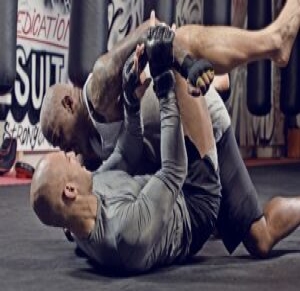With the rise of mixed martial arts (MMA), a variety of lower extremity injuries can occur, injuries which are not as frequent as mainstream athletics. The diversity of MMA often means that training can be broken down into different types of training. Some traditional martial artists or kickboxer’s training will involve a series of activities including stretching, basic techniques and combinations, bag and/or pad training, and periodic sparring. As the industry has become a commercialized one, new types of training have become very popular, one in particular, aerobic kickboxing. This type of training or exercise involves utilizing martial arts techniques combined with traditional aerobic exercises. A class of aerobic kickboxing will combine stretching, basic techniques and combinations in an aerobic type format.
Training Form
Before one participates in martial arts training or aerobic kickboxing the participant must stretch extensively before a training session. By stretching the amount of minor soft tissue injuries such as muscle strains, tendon strains will be decreased. Stretching should be performed for a minimum of fifteen to thirty minutes before commencing.
Injuries that can occur will vary – from minor injuries to severe and dehabilitating ones. When assessing aerobic kickboxing, injuries that occur are generally minor. Common podiatric-related injuries when performing aerobic kickboxing are; plantar fasciitis, Achilles tendonitis, sesamoiditis, and ankle sprains. Traditional martial arts drills can involve striking pads, a heavy bag, and/or another student, the injuries become more extensive. In addition to the injuries mentioned above, traditional martial arts injuries include; fractures, hematomas, and dislocated joints and tendons.
Plantar fasciitis or plantar fascial injuries can occur when training due to the constant pivoting and elevation of the foot while performing kicks. The mechanics of performing a front or roundhouse kick involves the supporting leg pivoting on the ball of the foot, while the other leg is in the air striking the target. The fascial injury can occur on the supporting leg due to the strain on the fascia, or a fascial injury can occur on the striking leg due to the repetitive pushing off and tightening of the fascia when beginning the kick.
Achilles tendonitis is another common injury during martial arts training. The Achilles tendon is involved when bringing the foot into position for many of the kicks, and is also responsible for the initiating motion when performing a kick. Depending on the individual one can perform over 500 kicks in a training session, which can cause overuse injury to the Achilles tendon resulting in tendonitis when training.
Seasmoiditis is another type of repetitive motion related injury. When performing kicks properly, the supporting foot is elevated onto its metatarsal heads, which allows the supporting leg to pivot. The long bone behind the big toe has two small round-shaped bones underneath the head of this bone. These bones can become irritated and inflamed and cause pain just behind and under the big toe.
As with many other sports, ankle sprains are very common in martial arts training. The abundance of side-to-side motion and one-limb support while kicking makes this injury a common one when training.
Other Injuries
With the addition of contact activities in traditional martial arts, fractures are common in the foot and ankle. Common types of fractures while training are; digital fractures, and metatarsal fractures. With these types of injuries, the pain is severe and often results in the inability to bear weight on the limb. Swelling and bruising will often accompany the fracture. If any injury is severe enough to hinder your ability to walk, and a fracture is suspected, it is recommended that you visit your doctor, as some injuries may require surgery.
Other injuries can include dislocation of joints (digits most of the time), tendon dislocation (often feels like an ankle sprain), aswell as broken bones (often the fibula or tibia), which may require immediate surgery.
Conclusion
Combat sports are an excellent method of exercise, stress relief and confidence booster. As with any type of exercise, injuries are a common occurrence. Being able to identify the type of injury, and the proper treatment modality will allow for a faster recovery and a faster return to activity.
Dr. Bagwe is a leading orthopedic surgeon specializing in ankle and foot reconstruction. If you are looking for an orthopedic surgeon near you then look no further. Dr. Bagwe is an industry leader when it comes to foot and ankle surgery doctors in St. Louis. Dr. Bagwe and his friendly and professional team is ready to welcome you and tell you everything you need to know.
Reach out and contact us today.






